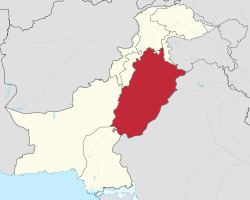Abbreviation P.P. Employees 180,000 | Formed 1861 | |
 | ||
Motto Serve And Protect / خدمت اور حفاظت Legal personality Governmental: Government agency | ||
The Punjab Police (Punjabi, Urdu: پنجاب پولیس) is responsible for reducing and controlling all the crimes, happening in the province of Punjab, Pakistan. The mission of the Punjab Police is only to serve the public by ensuring rule of law in every corner of the province. Despite of having limited resources and extreme socio political pressure Punjab Police has always showed dedication towards its work, professionalism depicts in the grace of their black collar uniform. It performs the first line of defence duty while eradicating the menace of terrorism from the great country.
Contents
Mughal Era
The system of policing in Mughal Era was organized on the basis of land tenure. Zamindars were responsible for apprehending disturbers of the public peace and performing other policing duties. At the level of the village these functions were performed by the village headmen. In large towns administration of the police was entrusted to, functionaries called kotwals who discharged the combined duties of law enforcement, municipal administration and revenue collection. Patrol officers in the shape of village watchmen or patels in villages and peons, horse patrolmen and such other like men in the towns were present. Violent organized crime was usually dealt with by the military.
British Era
The modern system of policing was introduced during British Rule, The British administration relieved the zamindars of their responsibility for police service and introduced magistrates with daroghas and other subordinate officers for Police purposes. The Punjab Police was also organized on the pattern of two main branches, the Military Preventive Police and the Civil Detective Police. As this arrangement was not found to be satisfactory so in 1860 the Government of India urged the Government of Punjab to look into the system of policing then prevalent in the Province. However, as the issue was of general importance the central Government appointed a commission to enquire into whole question of policing in British India. The Calcutta Police Commission of 1860 recommended the abolition of the Military Arm of the Police, the appointment of an Inspector General of Police in the Province and the placement of Police in a district under the District Superintendent. The Commission recommended that only the District Magistrate should exercise any Police functions. Based on the recommendations of the Commission the Government of India submitted a bill which was passed into law as Act V of 1861. The Police Act of 1861 was adopted. The organizational design that followed the Act survives to this day.
The Punjab Police Rules of 1934 documented the police practices as they stood at that time and introduced some new measures for improving administration and operational effectiveness of police. The content of the Rules reveals that the Punjab Police had grown into a thoroughly professional police organization by 1934 and possessed considerable knowledge of the crime and criminals in the province. It had developed effective procedures and practices for dealing with various kinds of criminal activity. The administrative and disciplinary functions were also elaborated. The Rules have served as the model for similar sets of rules in other provinces of Pakistan and are still in force today.
Punjab Police after Independence
The Punjab Police played a significant part in handling the refugee crisis of 1947-48. It continued as a separate organization till 1955 when it was merged with the police of other provinces to create the West Pakistan Police. The DIG West Pakistan was Inayat Ali Shah. DIG East Pakistan and DIG West Pakistan used to report to one IG which during the decade of the 1950s was Qurban Ali Khan. There were several attempts to review and reform police organization and performance during the 1950s and 60s which however could not be implemented. The legal framework of police in Pakistan underwent a major change as a consequence of Devolution of Power Plan implemented between 2001 and 2006. The Plan provided for devolution of a considerable portion of Provincial Government's authority and functions to districts and introduction of public accountability of police.
In line with Devolution of Power Plan, the office of Deputy Commissioner of the district was abolished in 2001 and a system of district governments was introduced through the Punjab Local Government Ordinance 2001. As a part of the Plan a new police law, the Police Order, replaced the Police Act 1861 in 2002. It brought sweeping changes to the police organization. The new law introduced public accountability in the form of Public Safety Commissions at district, provincial and national level. The Police Order 2002 also provided for an independent Police Complaints Authority, increased autonomy of the Inspector General of Police and instituted functional specialization by separation of investigation from other functions of Police. Currently the Punjab Police are engaged in counter terrorism operations in the province.
Organization of Punjab Police
The Punjab Police is constituted by the Police Order 2002 and operates under Police Rules of 1934. There is a Central Police Office (CPO) at Lahore which has a number of functional branches like Legal Affairs Division (Legal Branch),Finance & Welfare, Establishment, Operations, Training, Research & Development, etc. These units report to the Inspector General of Police through their respective Additional Inspectors General of Police. The Regional Police Officers report to the Inspector General of Police directly and they do not form part of the Central Police Office (CPO), Punjab. The Inspector General of Police is ex-officio secretary to the Government of Punjab. The Punjab Police is staffed by officers of the Punjab Police and the Police Service of Pakistan.
Specified forces in Punjab police department:
The main police formations are as follows:
Equipment
AK 47, MG3 MACHINE GUN, H&K G3, H&K MP5, Glock Series Pistols, Beretta 92fs, Shotguns, tear gas gun
Vehicles
Toyota Hilux (Single Cab & Double Cabin Vigo), Toyota Corolla, Toyota Land Cruiser, Toyata Land Cruiser(70 Series), Mohafiz (vehicle),
